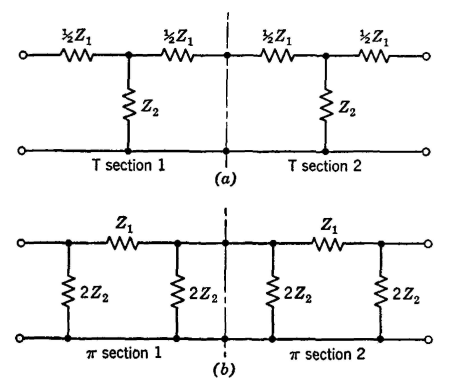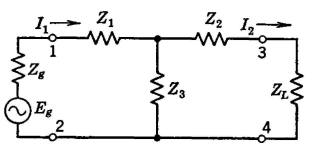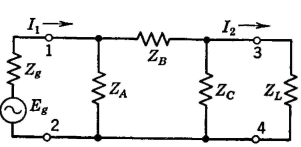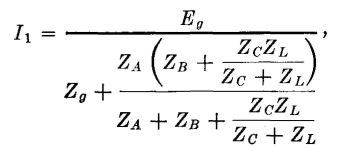| Electrical Communication is a free textbook on the basics of communication technology. See the editorial for more information.... |

|

Home  Electric Networks Electric Networks  Equivalence of T and Pi Sections Equivalence of T and Pi Sections |
|||||||||






|
|||||||||
Equivalence of T and Pi SectionsAssume that it is desired to construct a network such as Fig. 5(a). Because two series impedances 1/2Z1 add to give an impedance Z1 the circuit of Fig. 5(a) can be formed of the two T sections of Fig, 6(a). Also, a network such as Fig. 5(b) can be formed of the two π sections of Fig. 6(b). In communication circuits it sometimes is desired to find the π section that is equivalent to a T section, or vice versa. Two networks are of general equivalence1 "if one network can replace another network in any system whatsoever without altering in any way the electrical operation of that portion of the system external to the network." Two networks are of limited equivalence1 "if one network can replace another network only in some particular system without altering in any way the electrical operation of that portion of the system external to the networks." In the following discussion limited equivalence will be investigated. It is very important to note that networks often are constructed of impedances that vary with frequency; usually, networks are equivalent only at a given frequency.
In Fig. 7 are shown T and π networks. To derive the transformation equations from which an equivalent π section can be designed if
a T section is known (or vice versa) three equations will be written. For the T section, the impedance Z12 measured between terminals
1-2 is Z12 = Z1 + Z3, and for the π section the impedance Z12 = ZA(ZB + ZC)/(ZA + ZB + ZC). When these are equated,
The corresponding equations for impedances measured between terminals 3-4 are
The corresponding equations for impedances measured between terminals 1-3 are
These three equations can be solved simultaneously for Z1, Z2, and Z3 in terms of ZA, ZB, and ZC. By adding equations 1 and 3, and subtracting equation 2, it is found that
Likewise, adding equations 2 and 3, and subtracting equation 1 gives
and adding equations 1 and 2, and subtracting equation 3 gives
These equations are for transformation from a π to a T network. To make transformations from T to a π network, the equations prove to be2,3

and
It is now desired to show that if the two networks are related according to these equations they are equivalent and can replace each other without altering the circuit operation. For this Fig. 8 will be used, in which the two circuits, related in accordance with the equations just given, are connected between identical sources of voltage Eg, and identical load impedances ZL. If it can be shown that in each circuit the identical generators supply currents I1 that are exactly the same and that the identical load impedances ZL receive currents I2 that are exactly the same, then the T and π sections are equivalent as far as terminals 1-2 and 3-4 are concerned. For the T section of Fig. 8,
Because the voltage drops across two parallel branches must be equal,
and
The next step is to substitute in these two equations the values of Z1, Z2, and Z3 given in equations 4, 5, and 6. Making these substitutions in equation 10 and simplifying the expression gives
Making these substitutions in equation 11 gives
It now remains to derive expressions for I1 and I2 for the π section of Fig. 8, in terms of ZA, ZB, and Zc and to ascertain if these expressions agree with equations 12 and 13. Thus, for the π section of Fig. 8,
and simplifying,
To find the current I2 in the π section of Fig. 8 first it is necessary to find the current in impedance ZB, which can be determined from the relation
and
Similarly,
Substituting the value of IZB in this expression gives
It has been shown that equations 12 and 13 derived for the T section are identical to equations 14 and 15 derived for the π section. This proves that the sections will perform exactly alike when inserted between a source of voltage and a load impedance and that so far as terminals 1-2 and 3-4 are concerned T and π networks related by equations 4, 5, and 6, or 7, 8, and 9 are equivalent.
|
|||||||||
Home  Electric Networks Electric Networks  Equivalence of T and Pi Sections Equivalence of T and Pi Sections |
|||||||||
Last Update: 2011-05-30

























